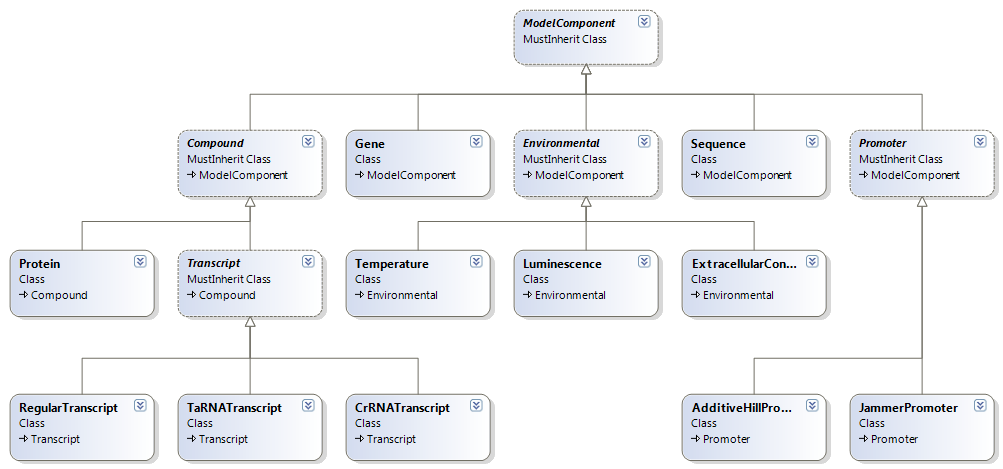Team:Groningen/modeling simulation engine
From 2011.igem.org
| Line 7: | Line 7: | ||
For our model we deterministic set of differential equations (ODE's and PDE's). All these act on the current model state to compute the next state of the model. This state represents all the important chacarteristics in a cell which we refer to as factors. | For our model we deterministic set of differential equations (ODE's and PDE's). All these act on the current model state to compute the next state of the model. This state represents all the important chacarteristics in a cell which we refer to as factors. | ||
| - | We distingish | + | We distingish four types of factors: |
| - | * Promoter activations, measures in polimerase bindings per second, for instance the activation of a | + | * Promoter activations, measures in polimerase bindings per second, for instance the activation of a LacI promoter |
| - | * | + | * Transcript concentrations, measured in nanomole per liter, for instance the concentration of an RNA molecule coding for cI. |
| + | * Compound concentrations, measured in nanomole per liter, for instance the concentration of an GFP molecule. | ||
* Environmental factors, measured in different units, for instance temprature or ligth exposure. | * Environmental factors, measured in different units, for instance temprature or ligth exposure. | ||
| - | Using these | + | Using these four types of factors we can generate new models states. By saving every model state we can plot the behavior of our system in a esealy readable way if needed. |
[Illustration] | [Illustration] | ||
Revision as of 09:00, 20 September 2011
The Cumulus simulation engine
Cumulus uses an internal single cell simulation engine to evaluate parameter settings. The simulation engine is a simple temporal integration over a collection of differential equations. As an input it takes a model of the cell to simulate, some starting conditions, and the input data relating to controlled environmental factors. The timescale we use is seconds since this seems a good middle ground that allows us to characterize the processes we are interested in typically the effects of reporters such as GFP. All faster processes such as diffusion of compound through the cell or the binding of induction factors to operating regions are assumed to occur instantaneously between time steps. Slower processes such as transcription and translation delays are explicitly modeled. The reason we do not allow the use of variable timescales is a these can yield numerically different solutions for the same data. While try to remain consistend between models but within the context of our modeling tool.
The model
For our model we deterministic set of differential equations (ODE's and PDE's). All these act on the current model state to compute the next state of the model. This state represents all the important chacarteristics in a cell which we refer to as factors.
We distingish four types of factors:
- Promoter activations, measures in polimerase bindings per second, for instance the activation of a LacI promoter
- Transcript concentrations, measured in nanomole per liter, for instance the concentration of an RNA molecule coding for cI.
- Compound concentrations, measured in nanomole per liter, for instance the concentration of an GFP molecule.
- Environmental factors, measured in different units, for instance temprature or ligth exposure.
Using these four types of factors we can generate new models states. By saving every model state we can plot the behavior of our system in a esealy readable way if needed.
[Illustration]
Promoter activations
Because several sequences in a cell can share a promoter it's activation is computed only once and then used for all RNA productions at the same time. The delay between the actual polymerase binding and the appearens of the first RNA is typically several minutes but can be longer depending on the length of the sequence and several other factors.
S
Promoter activations
Compound concentrations
All compounds have differential equations describing the changes in concentrations of both themselves and other compounds, All concentration changes are first calculated for all compounds seperately and then summed and added the the concentrations of
Rna sequences are not that different from other compound in that the equation
Compound concentrations
All compounds have differential equations decribing the changes in concentrations of both them selves All concentration changes are first calculated for all compounds seperately and then summed and added the the concentrations of
compound concentrations
Every Compound has a set op equations governing it
Model
=Basic types
- Sequence
- Compound
- Transcript
- Regular Transcript
- TaRNA Transcript
- CrRNA Transcript
- Promoter
- Additive Hill Promoter
- Jammed Promoter
- Gene
- Protein
- Temperature
- Extracellular Concentration
 "
"


